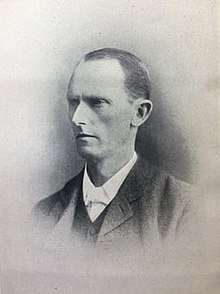Harry George Grey
Henry "Harry" George Grey (1851-1925) was an English missionary and theologian who served as third Principal of Wycliffe Hall.

Grey was the second son of Admiral George Grey (1809-1891) and thus a grandson of Prime Minister Earl Grey. Grey was educated at Wadham College, Oxford, graduating BA in 1873 and MA in 1876.[2]
After a training curacy in the London slums[3] , Grey served as Vicar of Holy Trinity Church, Oxford from 1876 to 1885 (a parish in the working-class suburb of St Ebbe's). The greatest part of Grey's ministry (1887-1909, with a break 1900-05) was spent as an agent of the Church Missionary Society in British India, particularly areas which would later become Pakistan, including Quetta, Amritsar, Lahore, and Gojra.[4] He began work in this field just as Bishop Valpy French was leaving it due to ill-health. Grey's work in the region was described by Thomas Ewing as earnestly labouring 'in a more honourable part of the master's field'.[5]
Grey returned to England and served as Principal of Wycliffe Hall, Oxford in succession to Francis Chavasse from 1900-05 & 1910-18, during which time he completed a number of scholarly works (noted below). Although Grey resigned the Principalship in 1905[6] for a second tour of service in India, he returned within five years. Grey worked intermittently during this time and beyond (until 1923) as Examining Chaplain for Chavasse, who had moved to serve as second Bishop of Liverpool. The final years at Wycliffe were clouded by the First World War, during which the institution served to house refugees from Serbia and trainees from the Royal Flying Corps. It was Grey's second cousin once removed, Edward Grey, who for most of the war was directing British foreign policy. This may have been the reason for the Flying Corps' stationing at Wycliffe.
After living at the Hannington Hall 1915-1921, and suffering acutely from arthritis[7] , Grey finally left Oxford (concluding an association with the city which had lasted over fifty years) to live with his sister, Mary Elizabeth Grey at Moreton Pinkney Manor House.[8] Following Grey's death in 1925, Chavasse (now in retirement in Oxford) published a biographical tribute to his old friend which includes a selection of Grey's sermons.[9]
Works
- St Paul's Epistle to the Romans (commentary) (1911)
- Baptism (1913)
- Comity in the Mission Field (1914)
- The Death of Christ (1916)
References
- Hills & Saunders of Oxford, undated photographic portrait
- Joseph Foster, Alumni Oxonienses (Later Series, Volume II) (London: Parker & Co., 1891), p.565
- The Record, 'Missionary, teacher, saint' (review article), 14 October 1926
- Crockford's Clerical Directory, 1921-22, p.613
- Oxford Journal, 19 October 1895 'Holy Trinity Church, Oxford: Jubilee Services', p.6
- M. Guthrie Clark, 'W.H. Griffith Thomas' (Church Book Room Press)
- Francis Chavasse, Harry George Grey: missionary, teacher, saint (London: CMS Publishing, 1926), p.17
- Kelly's Directory, 'Moreton Pinkney: Historical Description' (1898)
- Francis Chavasse, Harry George Grey: missionary, teacher, saint (London: CMS Publishing, 1926)